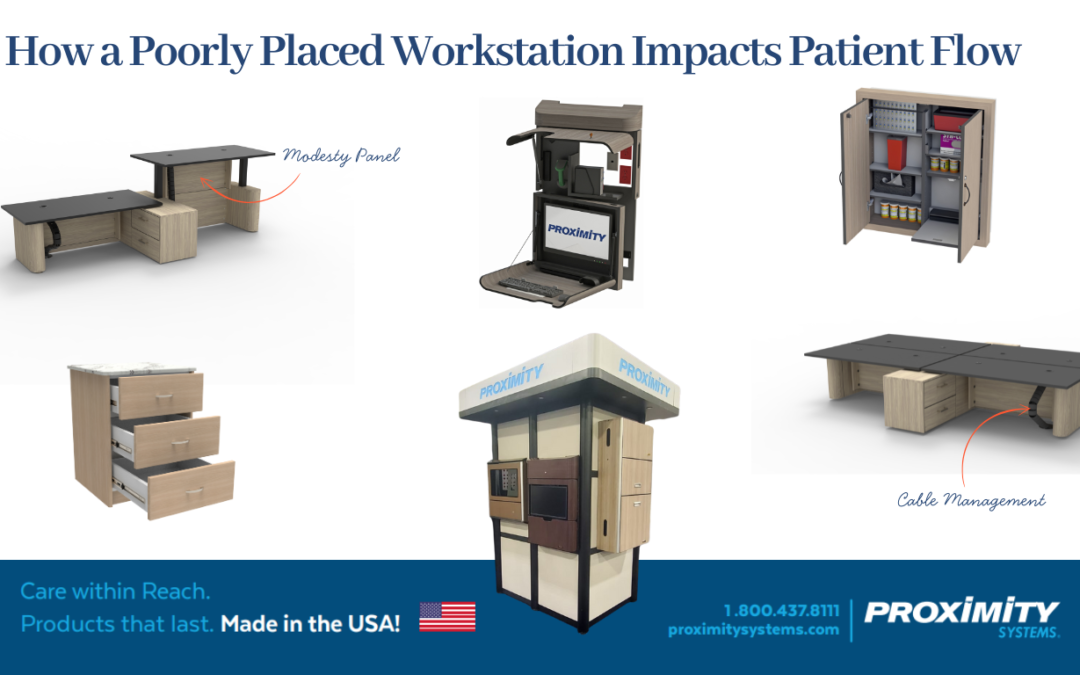In modern healthcare environments, workflow efficiency is a critical determinant of patient outcomes. Every second spent walking back and forth, searching for supplies, or navigating cramped spaces can add up to measurable inefficiencies in care delivery. Yet, one of the most overlooked contributors to these inefficiencies is often something deceptively simple: where a workstation is placed.
The Hidden Cost of Poor Placement
A workstation that’s even a few steps out of the natural workflow can disrupt the rhythm of patient care. Nurses and clinicians may spend unnecessary time moving between documentation stations, treatment areas, and patient rooms. Over time, those small inefficiencies compound into real operational challenges — longer patient wait times, staff fatigue, and even delayed interventions.
When placement doesn’t align with the care team’s movement patterns, it creates a ripple effect. A nurse walking 20 extra feet per patient interaction might lose more than 30 minutes in a shift. In high-volume departments such as emergency or oncology, that’s not just wasted motion — it’s lost care time.
The Ergonomics of Flow
Proper workstation placement is about more than convenience; it’s about ergonomic harmony. Clinicians require immediate access to documentation tools, supplies, and technology — without compromising infection control or patient visibility.
A poorly positioned workstation can lead to:
- Workflow interruptions due to frequent repositioning or shared access conflicts.
- Increased risk of errors as staff multitask between charting and patient monitoring.
- Staff discomfort and fatigue from repetitive reaching, bending, or navigating tight corners.
When workstations are designed and installed with ergonomic foresight, they become enablers of care — supporting clinicians instead of slowing them down.
Data Meets Design
Healthcare design research consistently reinforces that environmental layout directly influences clinical efficiency. Studies show that every 10% improvement in workflow layout can yield up to a 20% gain in time spent on direct patient care.
Well-placed workstations allow teams to:
- Chart in sight of patients, enhancing engagement and safety.
- Reduce walking distances and redundant motion.
- Improve communication between clinicians and departments.
It’s a subtle but powerful design principle: the closer the care, the better the outcomes.
Designing for Intentional Efficiency
Designing an effective workstation layout starts with understanding how clinicians move — not how furniture fits. This means collaborating early in the planning process to map workflow paths, patient movement, and care interactions.
Hospitals that integrate ergonomically optimized workstation placement into their design planning report tangible results: faster room turnover, lower staff burnout, and more consistent infection control adherence.
The Proximity Perspective: Built for Workflow
At Proximity Systems, every workstation is engineered with workflow science in mind. From ergonomic sit-stand desks and pivoting wall mounts to secure medication cabinets, our solutions are designed to adapt to the user — not the other way around.
Our design philosophy centers on three key principles:
- Placement Precision: Solutions that support clinical flow without impeding movement.
- Ergonomic Comfort: Height-adjustable and space-efficient designs that reduce fatigue.
- Infection-Smart Design: Surfaces and edges engineered for easier cleaning and pathogen control.
When workstations align with how care happens, clinicians work smarter — and patients receive care faster.
The Bottom Line
A well-placed workstation may seem like a minor detail, but in healthcare, every detail matters. Thoughtful workstation design isn’t just about aesthetics; it’s about enabling seamless, human-centered care.
If your facility is rethinking its workspace layout or planning for renovation, it’s worth asking:
Is your workstation placement helping — or hindering — patient flow? Talk to us today.
📞 (800) 437-8111
